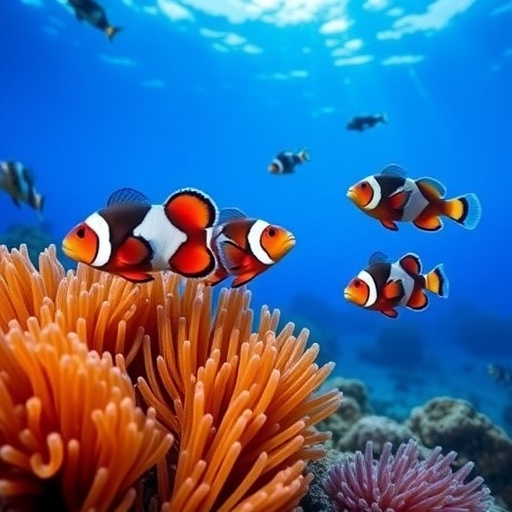In the blistering waters of the Red Sea, where summer temperatures routinely climb between 85 and 90 degrees Fahrenheit, a silent ecological catastrophe is unfolding. Recent research led by Boston University has revealed that marine heatwaves—extreme warming events occurring with increasing frequency—have wrought devastating damage on an iconic symbiotic duo: the clownfish (Amphiprion bicinctus) and their host sea anemones (Radianthus magnifica). Long admired for their uniquely interdependent relationship, these creatures have suffered a near complete local extinction in the central Red Sea in the wake of persistent and unprecedented thermal stress.
The Red Sea has long been eyed by scientists as a potential thermal refuge, a place where marine life might be shielded from the worst impacts of global warming due to its already elevated baseline temperatures. However, the findings of this new study, published in npj Biodiversity, have upended that hope. Over the past three years, marine heatwaves have pushed the boundaries of what these species can endure, shattering the resilience of ecosystems once thought to be robust enough to withstand climatic shifts.
Central to this ecological drama is the mutualistic relationship between clownfish and anemones, a partnership where both species derive benefit. Clownfish find shelter among the stinging tentacles of anemones, which in turn are protected and nourished indirectly by the fish. This relationship depends heavily on the health of the anemones, which harbor symbiotic algae called zooxanthellae within their tissues. These microscopic algae provide essential nutrients through photosynthesis, sustaining the anemone in exchange for shelter and access to light.
Yet, just as corals bleach when stressed by heat, so too do these anemones expel their zooxanthellae during periods of elevated temperature. The result is a whitening of the anemones—an alarming sign of physiological distress. When bleaching persists beyond a critical threshold, the anemone’s survival is jeopardized, precipitating a breakdown in the mutualism with clownfish. The Boston University team observed that in the aftermath of bleaching events lasting approximately six months during 2022 to 2024, clownfish mortality soared between 94% and 100%, while 66% to 94% of anemones perished.
The demise of clownfish is particularly poignant considering their behavioral adaptations. These small, brightly colored fish are typically camouflaged by the anemones’ tentacles, which offer protection from predators. Clownfish secrete a special mucus that renders them immune to the anemone’s sting, enabling them to coexist safely. When bleaching occurs and the anemone’s protective capabilities diminish—due in part to the compromised function of their stinging cells—clownfish find themselves out in the open. Their vibrant orange hue becomes starkly conspicuous against the bleached white backdrop, attracting predators and disrupting normal social interactions within fish groups.
Furthermore, behavioral shifts following bleaching have been documented. Increased aggression and conflict among clownfish result in weaker individuals being expelled from their anemone refuges. Without the safety net of the anemone’s tentacles, these vulnerable fish face heightened predation risk. The study highlights these compounding factors as critical contributors to population collapse, painting a grim picture of a mutualism unraveling under climate stress.
This research was spearheaded by Morgan Bennett-Smith, a PhD candidate at Boston University’s Marine Evolutionary Ecology Laboratory, who has spent over a decade studying these organisms in the Red Sea. Early encounters with bleached anemones in 2018 marked the beginning of a series of increasingly intense bleaching episodes. Collaborating with senior researchers like Peter Buston, the lab is delving deeper into the ecological mechanisms behind these population declines, including laboratory simulations that replicate bleaching conditions to observe effects on both anemone physiology and clownfish behavior.
Intriguingly, the team’s ongoing research extends beyond the Red Sea. Parallel studies in the waters surrounding Papua New Guinea, where Buston conducts frequent fieldwork, have revealed similar patterns of heat-induced stress and bleaching in local anemonefish populations. Notably, a collaborative study with Newcastle University found that clownfish in Papua New Guinea exhibit morphological changes, such as shrinking in size—an apparent survival strategy—to endure increasing temperatures.
These findings underscore the broader implications of localized extinctions in keystone species. Anemones and clownfish play vital roles in their ecosystems, shaping reef community structures through their interactions. The loss of such species can cascade through the reef environment, altering predator-prey dynamics and potentially triggering further biodiversity losses.
Despite the grim outlook, Bennett-Smith and his colleagues underscore the importance of continued monitoring and research. Their work advocates for comprehensive surveys across the Red Sea and globally to assess the conservation status of anemonefish and their host anemones more accurately. Enhanced understanding could inform restoration efforts and targeted conservation strategies aimed at bolstering resilience in these vulnerable communities before irreversible damage ensues.
This alarming study serves as a stark warning: even reputed thermal refuges are succumbing to the relentless advance of climate change. The intricate mutualisms foundational to ocean biodiversity are fraying under stress, threatening iconic species and the delicate balance of marine ecosystems. As the oceans continue to warm, such unraveling of ecological partnerships may become increasingly common, signaling urgent calls for global action to mitigate further damage.
Subject of Research: Animals
Article Title: Near complete local extinction of iconic anemonefish and their anemone hosts following a heat stress event
News Publication Date: Not explicitly stated; article publication date is 12-Sep-2025
Web References:
- Nature article: https://www.nature.com/articles/s44185-025-00107-4
- NOAA Marine Heatwaves: https://psl.noaa.gov/marine-heatwaves/
- BU Coral Bleaching Article: https://www.bu.edu/articles/2023/coral-scientists-study-how-to-save-coral-reefs-climate-change/
- 96% of oceans heatwave study: https://www.livescience.com/planet-earth/rivers-oceans/96-percent-of-oceans-worldwide-experienced-extreme-heatwaves-in-2023-new-study-finds
- Shrinking clownfish study: https://www.science.org/doi/10.1126/sciadv.adt7079
- Climate extremes info: https://climate.copernicus.eu/climate-indicators/sea-surface-temperature
References: DOI 10.1038/s44185-025-00107-4, npj Biodiversity
Image Credits: Morgan F. Bennett-Smith
Keywords: Marine biology, Climate change adaptation




